|
CPRI
CPRI stands for Common Public Radio Interface. According to CPRI specification, the definition and main motivation of CPRI is stated as follows :
(CPRI) is an industry cooperation aimed at defining a publicly available specification for the key internal interface of radio base stations between the Radio Equipment Control (REC) and the Radio Equipment (RE). The CPRI specification enables flexible and efficient product differentiation for radio base stations and independent technology evolution for Radio Equipment (RE) and Radio
Equipment Control (REC).
Followings are the list of the topics to be covered in this note.
In terms of Open RAN architecture, we would say CPRI is a commonly used data communication medium between RRU and DU as illustrated below. Historically, CPRI is mainly designed for 2G/3G and eCPRI is designed for LTE and NR, but it is all up to network infra structure vendors which type of CPRI (CPRI or eCPRI) to use for which radio access technology (i.e,
2G/3G, LTE, NR).
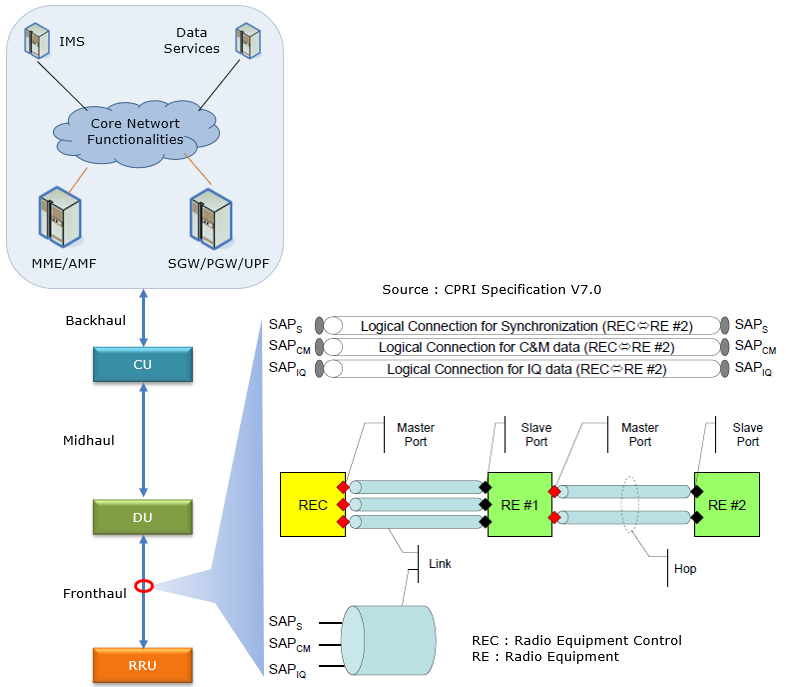
CPRI was developed mainly to replace conventional physical media (e.g, Copper cable) and some important motivation for CPRI are as follows :
- High Data Rates: CPRI supports very high data rates, up to 25 Gbps, which is much faster than conventional interfaces. This makes it possible to transmit large amounts of data quickly and efficiently.
- Reduced Latency: CPRI has very low latency, which is the delay between the transmission and reception of data. This is important for real-time applications such as voice and video, where even small delays can affect the quality of the user experience.
- Improved Flexibility: CPRI allows for more flexible network architectures, as radio equipment can be located farther away from the base station and connected via fiber optic cables. This allows for more efficient use of resources and greater scalability.
- Cost-Effective: CPRI can reduce the cost of mobile network infrastructure by enabling the use of lower-cost fiber optic cables instead of the more expensive copper cables used in conventional interfaces. Additionally, it can reduce the need for expensive repeaters and amplifiers, as the signal can be transmitted over longer distances without degradation.
- Interoperability: CPRI is a standardized interface, which means that equipment from different vendors can be easily integrated into the network. This helps to ensure interoperability and reduces the risk of vendor lock-in. ==> Even though CPRI is designed for a standardized interface, there was still some rooms for proprietary implementation which make it harder implement it to work for single CPRI to work for every customer.
Even though CPRI has various advantages mentioned above, it has chanlleges as well. Some of the challenges and disadvantages are listed below.
- Complexity: CPRI is a complex technology that requires specialized skills and knowledge to design, implement, and maintain. This can increase the cost of deployment and make it more difficult for smaller operators to adopt.
- Compatibility: CPRI is not compatible with legacy equipment, which means that operators may need to replace their existing infrastructure in order to adopt the technology. This can be costly and time-consuming.
- Distance Limitations: While CPRI supports longer distances than conventional interfaces, there are still limitations to the maximum distance that can be covered. This can be a challenge for operators looking to extend their network into remote or rural areas.
- Interference: CPRI signals can be affected by electromagnetic interference (EMI) from other equipment, which can lead to signal degradation and loss of data. This can be particularly problematic in dense urban environments where there are many sources of EMI.
- Cost: While CPRI can be cost-effective in the long run, there are initial deployment costs associated with upgrading to the technology. This can be a challenge for operators who are already operating on tight budgets.
CPRI support multiple levels of discrete throughput depending on various options that are summarized in the table shown below.
Following table is from the summary of CPRI specification - section 4.2. Physical Layer (Layer 1) Specification
|
Option
|
Bit Rate
(Mbits/sec)
|
Line Coding
|
Bit Rate Calculation
(Mbits/sec)
|
Electrical
|
Optical
|
|
Short Range
|
Long Range
|
| Option 1 |
614.4
|
8B/10B
|
1 x 491.52 x 10/8
|
E.6
|
OS.6
|
OL.6
|
| Option 2 |
1,228.8
|
8B/10B
|
2 x 491.52 x 10/8
|
E.12
|
OS.12
|
OL.12
|
| Option 3 |
2,457.6
|
8B/10B
|
4 x 491.52 x 10/8
|
E.24
|
OS.24
|
OL.24
|
| Option 4 |
3,072.0
|
8B/10B
|
5 x 491.52 x 10/8
|
E.30
|
OS.30
|
OL.30
|
| Option 5 |
4,915.2
|
8B/10B
|
8 x 491.52 x 10/8
|
E.48
|
OS.48
|
OL.48
|
| Option 6 |
6,144.0
|
8B/10B
|
10 x 491.52 x 10/8
|
E.60
|
OS.60
|
OL.60
|
| Option 7 |
9,830.4
|
8B/10B
|
16 x 491.52 x 10/8
|
E.79
|
N/A
|
N/A
|
| Option 7A |
8,110.08
|
64B/66B
|
16 x 491.52 x 64/66
|
E.96
|
OS.96
|
OL.96
|
| Option 8 |
10,137.6
|
64B/66B
|
20 x 491.52 x 64/66
|
E.99
|
OS.99
|
OL.99
|
| Option 9 |
12,165.12
|
64B/66B
|
24 x 491.52 x 64/66
|
E.119
|
OS.119
|
OL.119
|
| Option 10 |
24,330.24
|
64B/66B
|
48 x 491.52 x 64/66
|
E.238
|
OS.238
|
OL.238
|
CPRI fame has a multiple lavel of hierarchy from the I/Q sample data to hyperframe in the order of
I/Q Samples-->AxC --> AxC Group --> AxC Container --> AxC Container Group --> Basic Frame --> Hyperframe
NOTE : Refer to this tutorial at Amarisoft TechAcademy for the real example of an implementation
Frame Structure of CPRI is illustrated below. The word number (W) in a base frame is same but the byte number (Y) is different depending data rate (i.e, CPRI option). The fundamental building block of CPRI frame is called 'basic frame' and 256 basic frames comprises a Hyper frame.
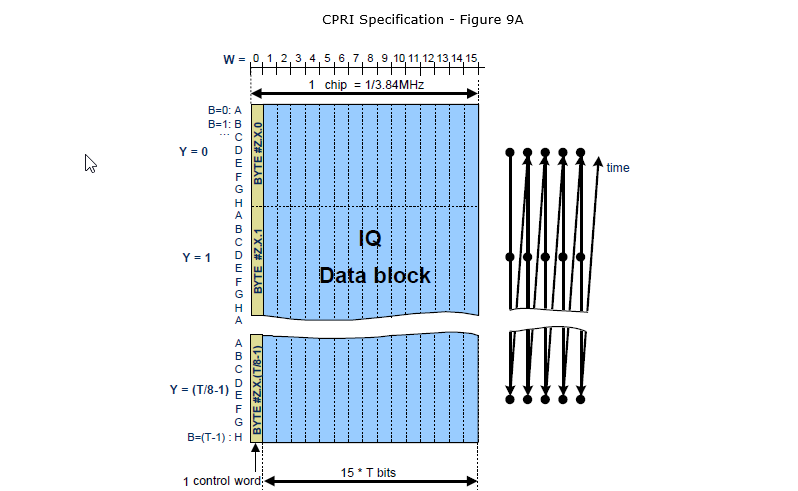
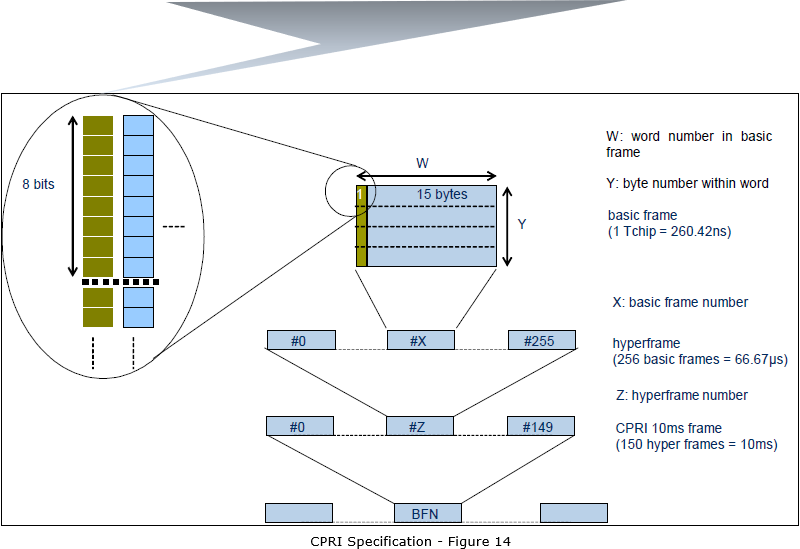
< CPRI specification - Table 6: Value ranges of indices >
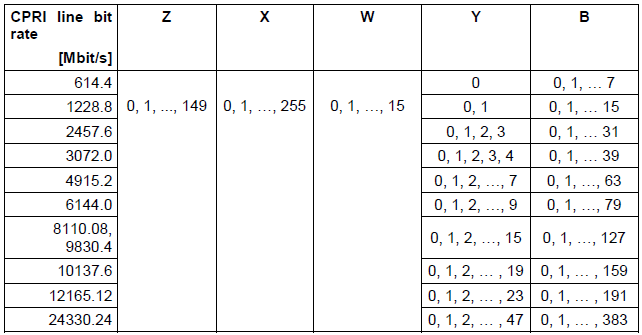
CPRI carries two type of information. One is for data and the other one is for control. Both data and control information is carried together in the basic frame. The position and structure of control information within a basic frame and hyperframe can be illustrated as follows.
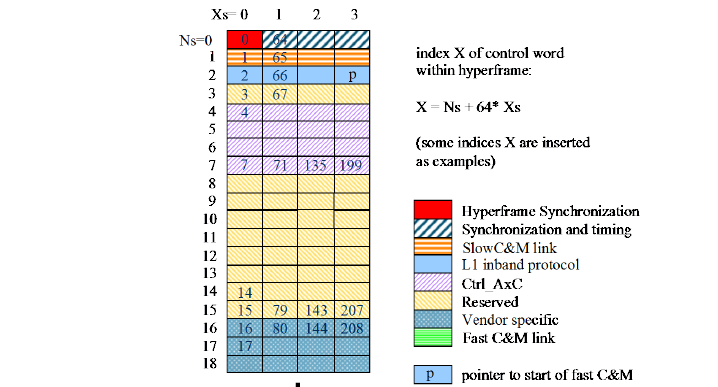
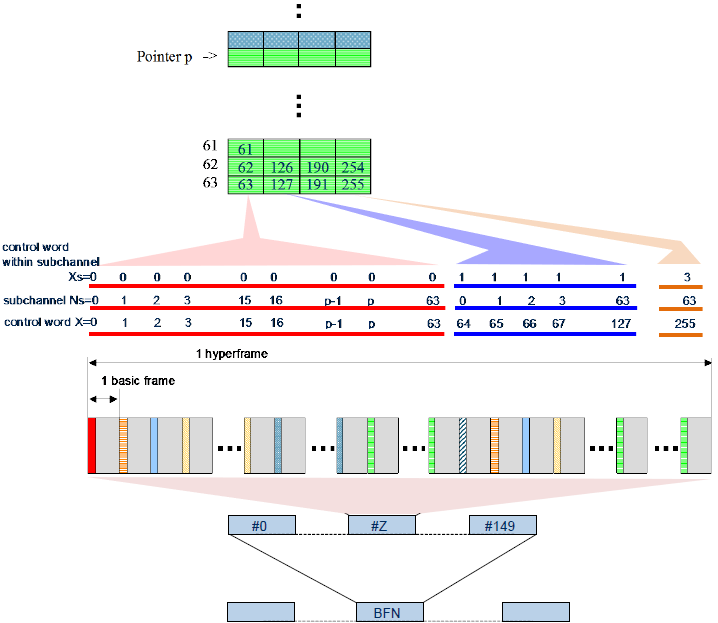
< CPRI specification - Table 7: Implementation of control words within one hyperframe for pointer p > 19 >
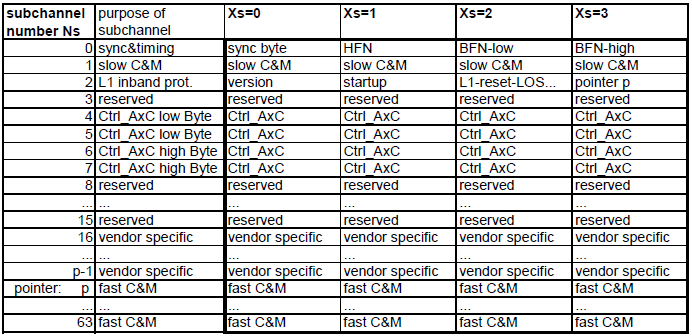
AxC stands for Antenna-Carrier. One antenna-carrier is the amount of digital baseband (IQ) U-plane data necessary for RX and TX of only one carrier at one independent antenna element.
AxC Hierarchy
There are several levels of hierarchy related to AxC that is illustrated in the CPRI specification as shown below.
< CPRI Specification v7.0 - Figure 1A: Illustration of basic definitions >
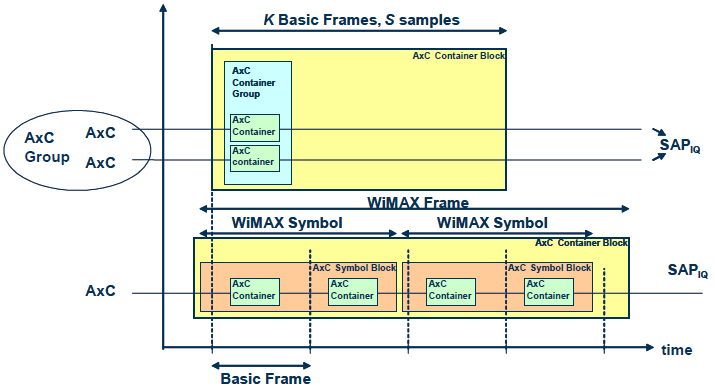
This is description of each components in the hierarchy
-
Antenna-carrier (AxC): An AxC represents the fundamental unit of digital baseband (IQ) data in a CPRI system, specifically the amount required for either the transmission or reception of a single carrier signal on one independent antenna element.
-
AxC Group: An aggregation of multiple AxCs (NA) that share identical attributes, such as sample rate, sample width, destination SAPIQ, and radio frame length. If NA = 1, then the AxC Group is equivalent to a single AxC.
-
AxC Container: A discrete segment within the IQ data block of a basic frame. The size is always an even number of bits, and it encapsulates the IQ data of a single AxC for a specific time duration (e.g., one UMTS chip for UTRA-FDD).
-
AxC Container Group: This is a collection of NC AxC Containers that hold the IQ samples for a corresponding AxC Group within a single basic frame. The value of NC is determined by parameters such as the number of antennas, carriers, and the specific radio technology being used.
Inter-relation of these components within the hierarchy can be summarized as
Implication of the Hierarchy
High level implication of this hierarchy can be summarized as follows :
-
Data Granularity: The diagram emphasizes the fundamental unit of data transmission, the Antenna-Carrier (AxC). It represents the IQ data for a single antenna carrying a single carrier signal, highlighting the specificity of data streams in modern multi-antenna, multi-carrier systems.
-
Hierarchy and Aggregation: The diagram beautifully illustrates the hierarchical aggregation of AxC data into progressively larger structures. AxCs are grouped together based on shared characteristics like sample rate and destination, forming AxC Groups. These groups are then encapsulated into AxC Containers, which are the building blocks of a Basic Frame.
-
Frame Structure: The concept of a Basic Frame is pivotal in the diagram. It represents a fixed time duration and acts as a fundamental unit of data transmission in the CPRI link. Multiple AxC Containers can fit within a Basic Frame, and their arrangement is governed by specific rules.
-
Flexibility and Vendor Specificity: While the diagram outlines a general framework for CPRI data organization, it also acknowledges the flexibility allowed for vendor-specific implementations. For instance, the content and format of an AxC Container can vary depending on the specific base station architecture and the type of data being transmitted.
- Modularity: The hierarchical design of CPRI data structures (AxC, AxC Group, Container, etc.) allows for a "building block" approach, where components can be flexibly combined to suit various system configurations and radio technologies.
- Efficiency: By grouping data into containers and frames, CPRI minimizes the extra information (overhead) needed for transmission, ensuring smooth, timed delivery of information essential for real-time communication.
- Adaptability: The inclusion of WiMAX-specific elements like AxC Symbol Blocks demonstrates CPRI's ability to adapt to diverse wireless standards, accommodating the unique requirements of each technology.
YouTube
Reference
|
|







